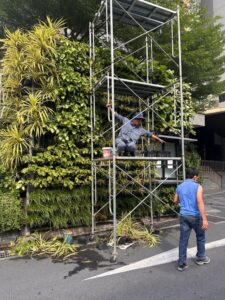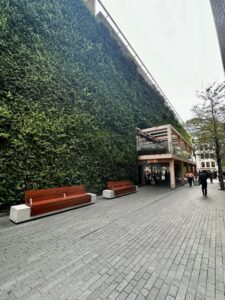
Designing with confidence:
Eliminating fear of green infrastructure in the built environment
By Michael Casey
In recent years, green infrastructure has become a buzzword in our industry and for good reason. I believe plants, with their remarkable ability to deliver multiple benefits, will be one of our most effective tools in mitigating the impacts of climate change. Whether it’s green roofs, raingardens, urban forests or green wall systems, the integration of vegetation into the built form offers a long list of social, environmental and economic benefits. From cooling and air purification to stormwater management, biodiversity and even increased property value, the advantages are well-documented. Yet, despite this, there is still a noticeable hesitation among many in the architectural and building sectors to adopt these solutions with confidence.
That hesitation often comes from fear; a fear of failure, fear of maintenance issues, maintainability and their associated costs, fear that the living system won’t perform or might even compromise the project. These fears are understandable. After all, we’re dealing with living materials, dynamic climates, and evolving ecosystems, and when you add in the complexity of microclimates, it’s clear that plant selection must be approached with care to ensure success. However, these fears are also holding us back, especially when we now have so much evidence, knowledge and experience to draw from to ensure success.
Green infrastructure doesn’t have to be unpredictable or high-risk, and when designed properly and embedded into a project from the early stages, it can be just as dependable as any engineered system. Much of the fear around green infrastructure stems not from the concept itself, but from poor application, design and advice provided from the start of a project.

There are many instances where green infrastructure is added as an afterthought, often misaligned with building systems that were never designed to support it or specified without the necessary expertise and in some cases resulting in outcomes that are destined to fail. Nature isn’t the problem; it’s more the concept of treating plants on buildings as a decoration rather than an integrated design element.
This is where collaboration becomes essential. The success of green infrastructure projects often depends on having the right professionals involved from the very beginning, ensuring that design, engineering, and horticultural considerations are fully integrated from the outset. That means bringing in trained horticulturists, landscape professionals, ecologists and accredited green infrastructure specialists during the planning phase and not at the end. These professionals understand how plants interact with buildings, how to manage water on-site, how to select resilient species for harsh urban conditions, and how to ensure systems thrive and can be maintained over time. Just as we rely on structural engineers for foundations or ESD consultants for sustainability reports, we need to recognise the specialist role green infrastructure professionals play.
Working with accredited practitioners also means risks are reduced, not increased. The industry is now backed by growing accreditation programs, performance guidelines and technical manuals, all compiled and peer reviewed by professionals in the industry. There are layers of design intelligence that make green systems not only resilient, but often low-maintenance and cost-effective over time.
Growing media depths, drainage profiles, irrigation systems, and plant selection can all be engineered with clear safety margins and defined performance criteria. With the right design approach, a green roof can last longer than a conventional one, a biofiltration system can double as a stormwater asset, and a façade planting system can insulate a building while softening its visual impact.
A major part of building trust in green infrastructure is shifting from assumptions to outcomes. Many of the fears in the industry stem from outdated beliefs or isolated failures. However, current data presents a different narrative, with evidence about green roofs having proven over and over that they reduce urban temperatures, filter air pollutants, increase property values, and even extend the life of waterproofing membranes by shielding them from extreme temperatures.
Green roofs are often blamed for causing leaks, and while poor plant selection or inadequate protection layers may contribute in some cases, the primary cause of failure is frequently the roofing structure itself, or the waterproofing membrane applied beneath. These issues are rarely the fault of green infrastructure systems alone. More often, they stem from a lack of communication and integration during the early stages of planning and design. When roofing and waterproofing professionals are involved from the outset and fully understand the scope of the proposed project, they are typically able to adapt their materials and methods to support green infrastructure successfully.
Municipal councils and developers across Australia are beginning to embed green infrastructure into masterplans and not just as a tick-box or feature, but as critical urban infrastructure. These projects are becoming increasingly important for the industry to review, critique, and learn from. By analysing real-world applications, professionals can gain insights into best practices, challenges, and innovative solutions. Organisations like Green Roofs for Healthy Cities provide valuable resources, including case studies and industry surveys, that highlight the performance and benefits of green infrastructure projects across North America.
Here in Australia the Australasian Green Infrastructure Network are doing the same for the professionals they represent in Australia and New Zealand. Such resources serve as educational tools, offering evidence-based information that can guide future designs and implementations. Engaging with these materials allows architects, builders, and planners to make informed decisions, reducing the fear of failure and fostering confidence in green infrastructure solutions.
Of course, no system is without risk. Every building component, from plumbing to HVAC to cladding, requires planning, performance testing and long-term maintenance. Green infrastructure is no different. But when treated with the same level of rigour and professionalism, its risks are entirely manageable, and the benefits far outweigh them. In fact, the biggest risk we face is not embracing these systems fast enough, especially in the face of increasing heat, declining tree canopy and worsening storm events in our cities. The future of our built environment will depend on how well we can integrate natural systems into the way we plan, design and construct.
Rather than being something to fear, green infrastructure should be seen as an opportunity to do things better for people, for the climate, and long-term urban resilience. As an industry, we have the tools, the talent and the knowledge to make this shift. What’s needed now is the confidence to move forward.
The call is simple, so let’s remove the fear. Let’s design smarter, collaborate earlier, work with professionals who know how to deliver living systems, and build the green into our grey. It’s time to stop treating green infrastructure as something “nice to have” and start treating it for what it really is – essential.
Michael Casey, Director,
Evergreen Infrastructure, Company Director,
Australasian Infrastructure Network
Technical Panel for the AIPH World Green Cities Awards
E: michael@evergreeninfrastructure.com.au
